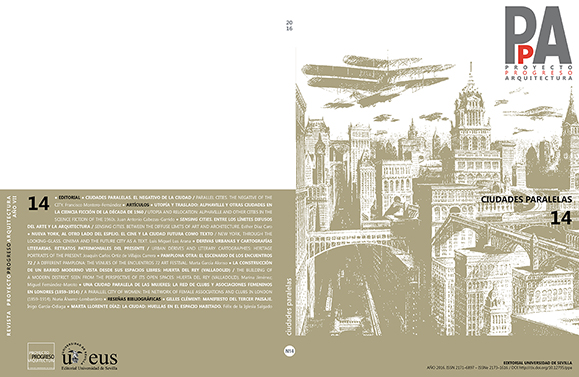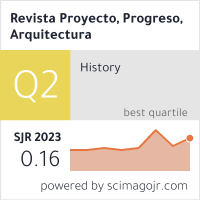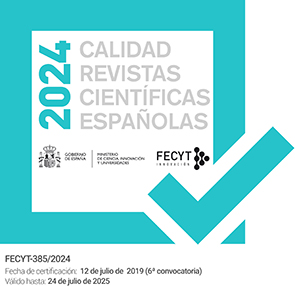UTOPÍA Y TRASLADO: ALPHAVILLE Y OTRAS CIUDADES EN LA CIENCIA FICCIÓN DE LA DÉCADA DE 1960 / Utopia and relocation: Alphaville and other cities in the science fiction of the 1960s
DOI:
https://doi.org/10.12795/ppa.2016.i14.01Palabras clave:
Arquitectura, ciudad, futuro, cine, ciencia ficción, 1960 / arquitecture, city, future, cinema, science fiction, 1960Resumen
RESUMEN En la ciencia ficción anterior a los años 60 del siglo pasado, los escenarios de la ciencia ficción estaban basados casi exclusivamente en decorados de estudio, maquetas, trucajes y pinturas mate. A partir de obras como La jetée (1962), del cineasta francés Chris Marker (1921-2012) comienza una tendencia que dura hasta nuestros días, en la que la arquitectura real se utiliza en ocasiones para representar el futuro. Un caso particular y efímero de este uso de la arquitectura consiste en utilizar la ciudad tal cual existe, filmada sin manipulaciones, en lugar de escoger fragmentos urbanos inconexos para componer otra nueva y futura. En lugar de trasladar la arquitectura hacia el futuro, el futuro es llevado al presente, en el que la ciudad se transforma en un lugar sin lugar. El Portmeirion de El prisionero, el París de Alphaville, la Buenos Aires de Invasión, son ejemplos de este modo de proceder, en el que el filtro cinematográfico consigue que lo urbano contemporáneo se reinterprete por el espectador hasta conformar un futuro tan creíble como diferente al de la ciencia ficción clásica, generando tantas experiencias diferentes como espectadores y multiplicando así la percepción de la ciudad.
SUMMARY In pre-1960s sciences fiction, scenarios were based almost exclusively on studio sets, models, special effects and matte paintings. Works such as La Jetée (1962), by French filmmaker Chris Marker (1921-2012) began a trend that continues to this day, in which architecture itself is sometimes used to represent the future. A particular and ephemeral case of this use of architecture is to use the city as it exists, filmed without modifications, instead of choosing disjointed urban fragments to compose a new and future one. Instead of moving architecture forward, the future is brought to the present, where the city becomes a placeless place. The Prisoner’s Portmeirion, the Paris of Alphaville, the Buenos Aires of Invasion, are all examples of this approach. Here, the cinematic filter ensures that the urban contemporary is reinterpreted by the viewer to form a future as believable and as different from classic science fiction, that it generates as many different experiences as it does spectators, thus multiplying the perception of the city.
Descargas
Citas
Augé, Marc: Los “no lugares”: Espacios del anonimato. Una antropología de la sobremodernidad. 1ª ed. en español [reimpresión]. Barcelona: Gedisa, 1994.
Ballard, J. G.: A user’s guide to the millennium: essays and reviews. Londres: HarperCollins, 1996.
Barber, Stephen: Ciudades proyectadas: cine y espacio urbano. 1ª ed. en español. Barcelona: Gustavo Gili, 2006.
Bioy Casares, Adolfo: La invención de Morel. Buenos Aires: Editorial Losada, 1940.
Borges, Jorge Luis: Otras inquisiciones. Buenos Aires: Emecé Editores, 1960.
Cournot, Michel: “Les Robots sonts déjà là”. En Le Nouvel Observateur, 6 de mayo de 1965. París: Perdriel, 1964.
Darke, Chris: Alphaville. Londres, Nueva York: I.B. Tauris, 2005.
Foucault, Michel: “Espacios otros”, trad. por Marie Lourties. En Versión. Estudios de comunicación y política. Abril 1999, nº 9. México D.F.: Universidad Autónoma Metropolitana. 1991. pp. 15-26.
Gorostiza, Jorge: La profundidad de la pantalla: Arquitectura+Cine. Santa Cruz de Tenerife: Colegio Oficial de Arquitectos de Canarias, Demarcación de Tenerife, La Gomera y El Hierro, 2007.
Hartley, John: Uses of Television. Nueva York: Routledge, 1999.
Suvin, Darko: Metamorphoses of science fiction: on the poetics and history of a literary genre. New Haven: Yale University Press, 1979.
McLuhan, Marshall: The Gutenberg Galaxy: The Making of Typographic Man. Toronto: University of Toronto Press, 1962.
McLuhan, Marshall: Understanding Media. Nueva York: New American Library, 1964.
Rohmer, Eric: L’organisation del’espace dans le Faust de Murnau. Paris: Union generale d’editions, 1977.
Sorrentino, Fernando: Siete conversaciones con Jorge Luis Borges. Buenos Aires: El Ateneo, 1996.
Telotte, J. P.: El cine de ciencia ficción. 1ª ed. en español. Madrid: Cambridge University Press, 2003.
Vizcaíno, Marcelo: “Originalidades reveladas en la ciudad futura cinematográfica”. En Arquiteturarevista. Enero-junio 2010, Vol. 6, Nº 1. São Leopoldo, Brasil: Universidade do Vale do Rio dos Sinos. 2005. pp. 37-49.
Descargas
Publicado
Cómo citar
Número
Sección
Licencia
Las ediciones impresa y electrónica de esta Revista son editadas por el Secretariado de Publicaciones de la Universidad de Sevilla, siendo necesario citar la procedencia en cualquier reproducción parcial o total.
Salvo indicación contraria, todos los contenidos de la edición electrónica se distribuyen bajo una licencia de uso y distribución “Creative Commons Atribución-NoComercial-SinDerivar 4.0 Internacional” ![]() . Puede consultar desde aquí la versión informativa y el texto legal de la licencia. Esta circunstancia ha de hacerse constar expresamente de esta forma cuando sea necesario.
. Puede consultar desde aquí la versión informativa y el texto legal de la licencia. Esta circunstancia ha de hacerse constar expresamente de esta forma cuando sea necesario.
Los autores/as que publiquen en esta revista aceptan las siguientes condiciones:
- Los autores/as conservan los derechos de autor y ceden a la revista el derecho de la primera publicación, con el trabajo registrado con la licencia de atribución de Creative Commons, que permite a terceros utilizar lo publicado siempre que mencionen la autoría del trabajo y a la primera publicación en esta revista.
- Los autores/as pueden realizar otros acuerdos contractuales independientes y adicionales para la distribución no exclusiva de la versión del artículo publicado en esta revista (p. ej., incluirlo en un repositorio institucional o publicarlo en un libro) siempre que indiquen claramente que el trabajo se publicó por primera vez en esta revista.
- Se permite y recomienda a los autores/as a publicar su trabajo en Internet (por ejemplo en páginas institucionales o personales) antes y durante el proceso de revisión y publicación, ya que puede conducir a intercambios productivos y a una mayor y más rápida difusión del trabajo publicado (vea The Effect of Open Access).









